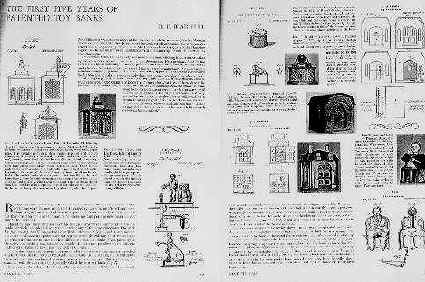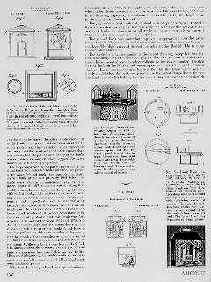ANTIQUES - March, 1941
THE FIRST FIVE YEARS OF
PATENTED TOY BANKS
By H. BLAIR HULL
Note: This article was prepared largely at the instance and
with the assistance of the late Norman Sherwood of Spring Lake, New Jersey, whose
knowledge of old mechanical toy banks was extensive and of long standing. He submitted Mr.
Hull's article to ANTIQUES and the Magazine regrets that he did not live to see it
published. With the manuscript he sent the following introductory notes:
"While Blair Hull is a comparatively new name in the bank collecting field, its owner
makes up for relative inexperience in enthusiasm and in thoroughness. He is peculiarly
fitted for the special study he has undertaken — namely, patent research in the field
of toy banks, mechanical and otherwise. When introduced to his work I had no idea of its
importance. My initial skepticism soon changed to genuine interest and then to a deep
appreciation of the real contribution he has been able to make in a comparatively short
time to our knowledge of the whole subject. I had always depended for information about
toy banks upon advertising dodgers, leaflets, trade catalogues, house organs, and jobbers'
catalogues, plus what I could learn directly by investigating the still-existing
foundries, their history and traditions. Now that Blair has come along to do this job of
patent research, a whole new avenue of information is opened. I feel very appreciative,
and very grateful for the opportunity given me to collaborate, to a certain extent, in the
good work. The best I can wish for Blair Hull — and for every other enthusiastic
collector — is that he may find all the rare mechanical banks which his research
discloses as having existed."


BETWEEN 1869 and
1910, well over three hundred different mechanical banks, including varieties now
important to collectors, were manufactured and merchandised, and nearly all of these were
patented. A careful study of early patents has therefore afforded a great quantity of
interesting and perhaps new material pertaining to old banks.
One of the most interesting results of this study is discovery of a number of patents for
banks of which examples are not yet included in any of the large collections. The 1870 boy,
frog, and dog, the 1870 slogan bank described in
this article (Figs. 2 and 3), and numerous other
banks shown in patents are not represented in the existing ten or twelve large collections
of from two to three hundred different mechanical banks. These patents give the collector
something new to look for, though it is, of course, possible that the hitherto
undiscovered banks were not manufactured in quantity.
The patent papers are frequently of considerable help where a missing part is needed and
the owner does not have access to a duplicate bank. In many cases, the patent shows the
exact form and mechanical structure as used in manufacture. This is the case, for example,
with the race course bank, usually called the horse
race bank (Fig. 4).
It was one of the rules of the Patent Office, made effective in 1870, that when a bank was
placed on the market the patent application must be filed within a period of two years in
order to secure protection. This regulation gives reasonable assurance that the bank was
not made earlier than two years before the patent date. Many of the banks marked Patent
Pending or Patent Applied For were made during
this two-year period.
Usually comparison of the patent papers with the actual bank will indicate which came
first, the patent or the manufactured bank. For example, the Hall's excelsior
bank patent was probably filed before the banks were actually manufactured (Fig. 1). The patent paper of
1869 shows an outside string that could be easily broken by the first boy or girl to play
with such a bank, and a cashier's desk as a cubical box made of several pieces of wood
— rather expensive and impractical from a manufacturing basis. A later patent of 1875
shows the string on the inside and the cashier's desk exactly as made on banks found in
almost all present collections. It is, therefore, quite probable that this bank was first
actually made and sold between 1869 and 1875. It is also of interest to note that the
patent shows a man as cashier, while most of the banks found have a monkey performing this
task. Another difference is that the monkey's head is sidewise when the top of the bank is
closed and not in the position shown in the patent. While this bank is very frequently
found, it is almost impossible to secure a really perfect and complete specimen, because
of their age and frailty. Thus, notwithstanding the modest value of ordinary specimens,
perfect examples with all original parts command good prices.
The home bank as produced was quite similar to the patent
drawing (Fig. 5).
Examples occur with and without the eight dormer windows but design patents cover the two
varieties. The word Cashier, not shown in the drawing, appears
on manufactured banks. Otherwise, the design shown in the patent was closely followed.
The frog on lattice bank is almost identical with the patent
design in regard to form and mechanism (Fig. 6). The base is similar
to that on the race course bank, and both banks are shown in an
old trade catalogue of Oscar Strasburger & Company, 443-445 Broadway, New York City.
The national bank was somewhat improved in appearance over the
patent design (Fig. 7).
The name National Bank was added, as well as the word Cashier
on the door. The slight curve on the roof line adds another flourish. This is a very rare
and desirable bank.
The novelty bank is very similar to the patent drawing, except
for the detail design of the upper part of the door (Fig. 8). The wide brim on the
cashier's hat would have presented some foundry problems, so this was eliminated. The door
has the knob on the left side and swings open on hinges at the right. Curiously the bank
has a bronze or pattern figure of the "tall thin teller" which was evidently
made before the bank was patented, as the patent design shows the conventional type of
teller holding the tray toward the right, so that the knob of the door would have had to
be on the right side and the hinges on the left. Moreover, the inside partition in the
bank would have had to be in exactly opposite position. Apparently the inventor had
considered making the bank in reverse of the conventional type either before he made his
patent sketches or before he produced the finished banks. The June 25, 1872, patent was on
one of the home banks, and evidently had little relation to the novelty
bank.
The Tammany bank patent drawing shows a much more complicated
mechanism than the actual manufactured bank (Fig. 9). The arm is held up by
a spring. The coin is placed in the hand of the seated figure which is held in the upward
position by a trigger wire. The trigger wire is then released and the weight of the coin
over-balances the spring, dropping the coin in a pocket hole. The bank as found does not
include the spring or trigger wire. Part of the arm is used as a counter-weight, greatly
simplifying the construction. An effigy of Boss Tweed is used on these Tammany
banks. Boss Tweed died in 1878, but the toy banks which poked fun at his habit of putting
coins in his own pocket have indeed lived after him. Literally thousands of these banks
have survived, indicating that tens of thousands must have been made.
ANTIQUES, March 1941, Page 138
The Editor's Attic
For Indian Pennies
AS INDICATED by the popularity of
the current exhibition at the Museum of Modern Art, this country appears to be
gaining a new appreciation of the noble redskin and his contribution to culture.
Further to stimulate this laudable development, the Attic takes delight in
presenting an example of aboriginal art in the collection of H. L. Durrell of
San Diego, California (Fig. 1). In this choice bit of early Americana, Chief Big
Moon sits stoical and patient at the entrance of his tepee. No war whoop will
rouse him to action; no bit of wampum will kindle a gleam in his metallic eye.
But judicious application of a copper penny — an Indian penny, by all means
— will cause a shift in the scene. Though Chief Big Moon still remains
unmoved, before him a big frog pops up from a little puddle, and in the latter
the penny is straightway submerged.
It is said that the symbolism of American Indian art is frequently difficult to
interpret. Many of the motives have become, through countless generations,
stylized beyond recognition, and their meaning is half-forgotten even by those
who perpetuate them. In the case of the rare curiosity here illustrated, surely
it will take a student, not only well versed in Indian lore, but thoroughly
acquainted with outworn customs of the white man, to grasp its full
significance. The Attic can only suggest that the cryptic signs along its base
may be an Indian translation of the wise old saying, "A penny saved is a
penny earned!"
